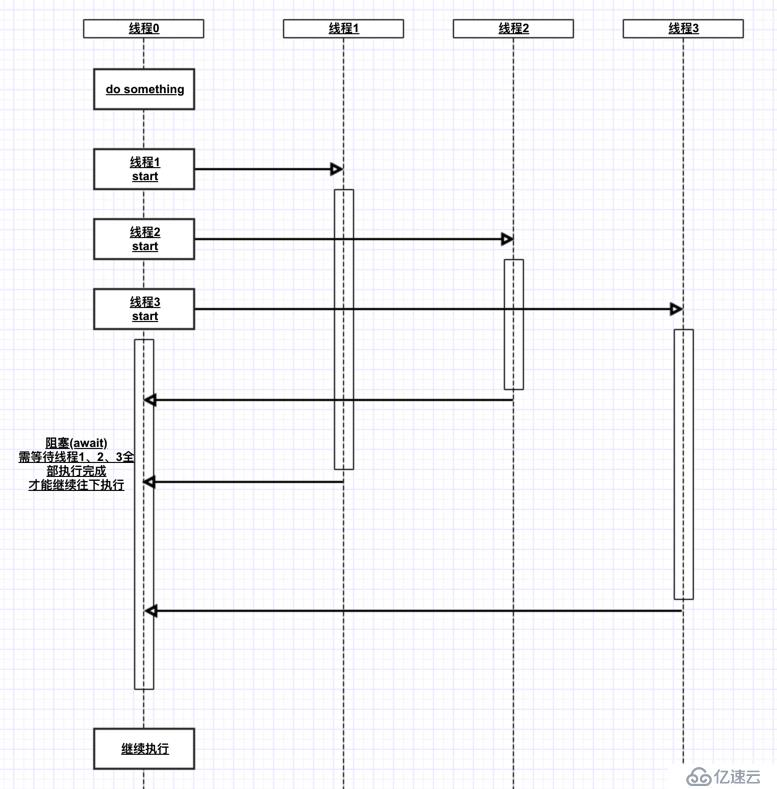您好,登錄后才能下訂單哦!
您好,登錄后才能下訂單哦!
CountDownLatch作為一個多線程間的同步工具,它允許一個或多個線程等待其他線程(可以是多個)完成工作后,再恢復執行。
就像下面這樣:

我們直接拿源碼中給出的Demo看一下,源碼中的這個demo可以看做模擬一個賽跑的場景。 賽跑肯定有跑得快的運動員也有跑的慢的運動員,每個運動員就表示一個線程。 運動員聽到槍聲后開始起跑,而最后一個運動員到達終點后,標志的比賽的結束。 整個過程如下圖所示:
源碼如下所示
public class Race {
private static final int N = 4;
public static void main(String[] args) throws InterruptedException {
CountDownLatch startSignal = new CountDownLatch(1); // 鳴槍開始信號
CountDownLatch doneSignal = new CountDownLatch(N); // 等待N個運動員都跑完后,比賽結束(結束信號)
for (int i = 0; i < N; ++i) // N個運動員準備就緒,等待槍聲
new Thread(new Runner(startSignal, doneSignal, i)).start();
Thread.sleep(1000); // 等待所有運動員就緒
System.out.println("所有運動員就緒");
startSignal.countDown(); // 鳴槍,開賽
System.out.println("比賽進行中...");
doneSignal.await(); // 等待N個運動員全部跑完(等待doneSignal變為0)
System.out.println("比賽結束");
}
}
class Runner implements Runnable {
private final CountDownLatch startSignal;
private final CountDownLatch doneSignal;
private int number;
Runner(CountDownLatch startSignal, CountDownLatch doneSignal, int number) {
this.startSignal = startSignal;
this.doneSignal = doneSignal;
this.number = number;
}
public void run() {
try {
// 等待槍聲(等待開始信號startSignal變為0)
System.out.println(number + "號運動員準備就緒");
startSignal.await();
// 賽跑
System.out.println(number + "號運動員跑步中...");
Thread.sleep(new Random().nextInt(10) * 1000);
// 此運動員跑到終點
System.out.println(number + "號運動員到達終點");
doneSignal.countDown();
} catch (InterruptedException ex) {} // return;
}
}上面代碼運行后,輸出如下:
0號運動員準備就緒
3號運動員準備就緒
2號運動員準備就緒
1號運動員準備就緒
所有運動員就緒
比賽進行中...
0號運動員跑步中...
1號運動員跑步中...
2號運動員跑步中...
3號運動員跑步中...
2號運動員到達終點
1號運動員到達終點
0號運動員到達終點
3號運動員到達終點
比賽結束下面,深入到代碼細節,看一下CountDownLatch初始化、countDown方法、await方法是如何實現的。
通過下圖來了解一下CountDownLatch的類繼承關系
CountDownLatch類圖
3 CountDownLatch的初始化
CountDownLatch只有一個構造方法:
public CountDownLatch(int count) {
if (count < 0) throw new IllegalArgumentException("count < 0");
this.sync = new Sync(count);
}他會初始化一個Sync,這是他的一個內部類,類似于ReentrantLock,Sync也繼承于AbstractQueuedSynchronizer(AQS)。
AQS是個啥?可以參考筆者的另一篇文章:Java隊列同步器(AQS)到底是怎么一回事
然后看一下Sync的源碼
private static final class Sync extends AbstractQueuedSynchronizer {
private static final long serialVersionUID = 4982264981922014374L;
// 調用AQS的setState方法,將state賦值為count的值
Sync(int count) {
setState(count);
}
// 獲取AQS state的當前值
int getCount() {
return getState();
}
protected int tryAcquireShared(int acquires) {
return (getState() == 0) ? 1 : -1;
}
protected boolean tryReleaseShared(int releases) {
// Decrement count; signal when transition to zero
for (;;) {
int c = getState();
if (c == 0)
return false;
int nextc = c-1;
if (compareAndSetState(c, nextc))
return nextc == 0;
}
}
}所以CountDownLatch的初始化,其實是將參數count的值賦值給AQS的state,依然是用state來控制同步狀態。
4 await方法的實現
依然用上面賽跑的例子來說明這個問題。這里我們只考慮所有運動員等待槍聲的情景。
回憶一下,賽跑的例子中,通過下面的方式創建了鳴槍信號:
CountDownLatch startSignal = new CountDownLatch(1); // 鳴槍開始信號然后創建了N個線程(表示N個運動員),并調用其start方法讓其開始執行(運動員準備就緒,等待鳴槍開跑)。
然后通過在run方法中調用startSignal.await(),來實現等待鳴槍的動作(其實就是等startSignal的值降為0)。
我們來看一下他是怎么await的。
public void await() throws InterruptedException {
sync.acquireSharedInterruptibly(1);
}調用了AQS的acquireSharedInterruptibly方法
public final void acquireSharedInterruptibly(int arg)
throws InterruptedException {
// 判斷線程是否已經被中斷
if (Thread.interrupted())
throw new InterruptedException();
// 調用CountDownLatch.Sync的tryAcquireShared方法
// 此方法判斷count的值是否==0,如果==0,返回1,否則返回-1
// 目前我們還沒有執行countDown,所以count肯定不等于0,這里肯定返回-1
// 所以會執行到AQS的doAcquireSharedInterruptibly方法中
if (tryAcquireShared(arg) < 0)
doAcquireSharedInterruptibly(arg);
}
protected int tryAcquireShared(int acquires) {
return (getState() == 0) ? 1 : -1;
}AQS.doAcquireSharedInterruptibly的實現如下
/
* Acquires in shared interruptible mode.
* @param arg the acquire argument
*/
// 此方法會在count>0時將當前線程加入到等待隊列中
// 由于我們目前還沒有執行countDown,所以count會保持>0
// 啟動的N個線程會全部加入到隊列中
private void doAcquireSharedInterruptibly(int arg)
throws InterruptedException {
// 將當前線程添加到等待隊列中(SHARED模式)
final Node node = addWaiter(Node.SHARED);
boolean failed = true;
try {
// 自旋獲取同步狀態
for (;;) {
final Node p = node.predecessor();
if (p == head) {
// 依然調用CountDownLatch.Sync的tryAcquireShared方法判斷
// 如果count降為0,退出自旋
int r = tryAcquireShared(arg);
if (r >= 0) {
setHeadAndPropagate(node, r);
p.next = null; // help GC
failed = false;
return;
}
}
// 將node的waitStatus設置為-1(常量SIGNAL,表示需要喚醒),并阻塞
if (shouldParkAfterFailedAcquire(p, node) &&
parkAndCheckInterrupt())
throw new InterruptedException();
}
} finally {
if (failed)
cancelAcquire(node);
}
}**
```**
假設N=4,那么4個線程全部start后,會全部加入到隊列中自旋等待,像下面這樣:
CountDownLatch.await自旋等待
5 countDown方法的實現
countDown方法實際上就是將AQS中的state的值-1。然后判斷當前state的值是否==0,如果等于0,說明所有線程都執行結束了,需要喚醒所有等待的線程。
依然繼續上面的場景,鳴槍后,所有的運動員開跑。
鳴槍這個動作實際上就是在主線程中執行:
startSignal.countDown();
這就相當于向剛才隊列中的所有線程發了一個恢復執行的信號,所有線程會被喚醒,繼續執行await后面的代碼。
countDown具體干了啥呢?public void countDown() {
sync.releaseShared(1);
}
他會調用AQS的releaseShared方法
public final boolean releaseShared(int arg) {
// 調用CountDownLatch.Sync的tryReleaseShared方法
// 該方法嘗試將count值-1,并判斷-1后的count是否==0,如果==0,返回true,否則false
// 該方法的源碼已經在Sync的源碼中給出,可翻閱上文查看
if (tryReleaseShared(arg)) {
doReleaseShared();
return true;
}
return false;
}
由于startSignal中count的初始值==1,startSignal.countDown()后,count變為0。所以tryReleaseShared會返回true。
然后開始執行doReleaseShared,喚醒隊列中的線程。
doReleaseShared是AQS中的方法。
/**
這里,被阻塞的線程又恢復執行,恢復到哪了呢?就是剛才自旋等待的那里。
把上面的源碼直接拿下來,再說明一下(注釋部分)
private void doAcquireSharedInterruptibly(int arg)
throws InterruptedException {
// 將當前線程添加到等待隊列中(SHARED模式)
final Node node = addWaiter(Node.SHARED);
boolean failed = true;
try {
// 線程被釋放后,繼續下一次循環
for (;;) {
final Node p = node.predecessor();
if (p == head) {
int r = tryAcquireShared(arg);
// 獲取頭節點,從頭結點開始釋放,由于count已經降為0,所以r >= 0為true
// 然后會將自己摘除當前隊列,使下一個節點成為頭節點
// 等下一個節點也恢復過來后,同樣執行上面的過程
// 這樣,隊列中的所有線程就被釋放了
if (r >= 0) {
setHeadAndPropagate(node, r);
p.next = null; // help GC
failed = false;
return;
}
}
// 將node的waitStatus設置為-1(常量SIGNAL,表示需要喚醒),并阻塞
if (shouldParkAfterFailedAcquire(p, node) &&
parkAndCheckInterrupt())
throw new InterruptedException();
}
} finally {
if (failed)
cancelAcquire(node);
}
}本文從源碼層面詳細說明了CountDownLatch是如何運作的。 CountDownLatch也是基于AQS實現,所以了解AQS的機制,對于理解本文至關重要。 其實,CountDownLatch最核心的就是通過控制AQS的state,來同步多個線程之間的狀態。
免責聲明:本站發布的內容(圖片、視頻和文字)以原創、轉載和分享為主,文章觀點不代表本網站立場,如果涉及侵權請聯系站長郵箱:is@yisu.com進行舉報,并提供相關證據,一經查實,將立刻刪除涉嫌侵權內容。